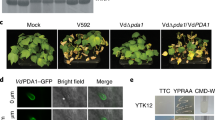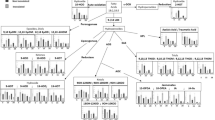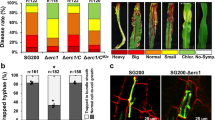Abstract
Expansin proteins, which have so far been identified only in plants, rapidly induce extension of plant cell walls by weakening the non-covalent interactions that help to maintain their integrity1. Here we show that an animal, the plant-parasitic roundworm Globodera rostochiensis, can also produce a functional expansin, which it uses to loosen cell walls when invading its host plant. As this nematode is known to be able to disrupt covalent bonds in plant cell walls2,3, its accompanying ability to loosen non-covalent bonds challenges the prevailing view that animals are genetically poorly equipped to degrade plant cell walls.
Similar content being viewed by others
Main
The plant cell wall is a rigid network of interwoven polymers, and many organisms that use plants as a food source use a variety of glycanase enzymes to break covalent bonds in this polysaccharide-based structure. We used complementary DNA–AFLP (for amplified fragment-length polymorphism)-based transcript profiling of synchronized life stages as a starting point to identify the proteins that are used by G. rostochiensis to degrade cell walls. A cDNA fragment, KT21 (137 nucleotides), was found to be predominantly expressed in infective second-stage juveniles (J2) and the corresponding full-length cDNA (Gr-Exp1; accession number AJ311901; length, 1,061 base pairs) encoded a protein of 271 amino acids that has a predicted amino-terminal signal peptide for secretion.
Similarity searches (BLASTP) indicated that two distinct regions are present in the predicted mature protein. Domain 1 (residues 26–118) shows significant similarity to the carbohydrate-binding module family II of endoglucanases (AF056110, BAB68522 and AF323087; 39–43% identity and expectation values (E-value) from 2.0×10−12 to 0.0008) from various nematode species. Domain 2 (residues 150–271) showed significant 'similarity to a β-expansin-like protein (PPAL) from Nicotiana tabacum (AAG52887; E-value, 2.2×10−5) and a putative β-expansin from Arabidopsis thaliana (O04484; E-value, 6×10−4). A local alignment of domain 2 with these β-expansins indicated the presence of a series of conserved cysteine residues, the HFD motif (although Gr-EXP1 harbours a conservative substitution (F→V)) and other conserved motifs4.
Whole-mount in situ hybridization was carried out on pre-parasitic infective second-stage juveniles of G. rostochiensis5. Antisense cDNA probes amplified from the Gr-Exp1 cDNA (nucleotides 54–427) hybridized specifically to the subventral oesophageal glands (Fig. 1a). Gr-EXP1 antiserum reacted strongly with nematode secretions, induced by potato-root diffusate, on dot blots (results not shown). We conclude that Gr-EXP1 is produced in the subventral oesophageal glands of infective juveniles, and that Gr-EXP1 and cell-wall-degrading enzymes6 are secreted simultaneously.
a, In situ hybridization labelling pattern in infective second-stage juveniles (J2) using a Gr-Exp1 antisense probe. Arrows indicate the subventral glands (S) and the metacorpus (M), respectively. Scale bar, 20 µm. b, Effects of nematode homogenate on the extension rate of heat-inactivated wheat coleoptiles and cucumber hypocotyls. Bar 1, J2 homogenate on wheat coleoptiles; bar 2, J2 homogenate on cucumber hypocotyls; bar 3, young female homogenate on wheat coleoptiles. c, Extension curves for a wheat coleoptile treated with mature-leaf extracts from Gr-Exp1-harbouring (upper curve) and empty-vector-harbouring (lower curve) tobacco plants. Arrow indicates the point at which the control buffer was replaced by leaf extract.
Cell-wall-extension activity7 was demonstrated in homogenates of infective second-stage juveniles, and was much stronger on wheat than on cucumber (Fig. 1b). Homogenates of adult females showed no such activity (Fig. 1b). Protein extracts from mature leaves of Gr-Exp1-transformed tobacco produced significantly more expansin activity on wheat coleoptiles than did empty-vector controls (Fig. 1c). On the basis of the significant similarity of Gr-EXP1 to putative β-expansins from N. tabacum and A. thaliana, the presence of several amino-acid motifs that are characteristic of expansins, and the potent expansin activity of both recombinant Gr-EXP1 and nematode homogenates on plant-cell walls, we conclude that Gr-Exp1 encodes a functional expansin.
Sequences that remotely resemble expansins have been found in various taxa outside the plant kingdom8,9,10, but cell-wall-loosening activity has not been demonstrated for any of the corresponding proteins. To our knowledge, Gr-Exp1 is the first non-plant gene found to have the structural and functional characteristics that define the expansin superfamily.
This finding undermines the previously accepted view that animals are poorly equipped for degrading plant cell walls. When cell-wall-degrading enzymes and expansin are simultaneously secreted by the cyst nematode, the activity of expansin may increase the accessibility of cell-wall components to glycanases. This might account for the remarkably high rate (about 2 min per cell layer) at which cyst nematodes can penetrate the host plant.
References
Cosgrove, D. J. Nature 407, 321–326 (2000).
Popeijus, H. et al. Nature 406, 36–37 (2000).
Jaubert, S., Laffaire, J. B., Abad, P. & Rosso, M. N. FEBS Lett. 522, 109–112 (2002).
Cosgrove, D. J. Curr. Opin. Plant Biol. 3, 73–78 (2000).
Qin, L. et al. Mol. Plant Microbe Interact. 13, 830–836 (2000).
Davis, E. L. et al. Annu. Rev. Phytopathol. 38, 365–396 (2000).
McQueen, M. S., Durachko, D. M. & Cosgrove, D. J. Plant Cell 4, 1425–1433 (1992).
Laine, M. J. et al. Physiol. Mol. Plant Pathol. 57, 221–233 (2000).
Saloheimo, M. et al. Eur. J Biochem. 269, 4202–4211 (2002).
Xu, B., Hellman, U., Ersson, B. & Janson, J. C. Eur. J Biochem 267, 4970–4977 (2000).
Author information
Authors and Affiliations
Corresponding author
Ethics declarations
Competing interests
The authors declare no competing financial interests.
Additional information
brief communications is intended to provide a forum for brief, topical reports of general scientific interest and for technical discussion of recently published material of particular interest to non-specialist readers (communications arising). Priority will be given to contributions that have fewer than 500 words, 10 references and only one figure. Detailed guidelines are available on Nature's website (http://www.nature.com/nature).
Rights and permissions
About this article
Cite this article
Qin, L., Kudla, U., Roze, E. et al. A nematode expansin acting on plants. Nature 427, 30 (2004). https://doi.org/10.1038/427030a
Issue Date:
DOI: https://doi.org/10.1038/427030a
This article is cited by
-
Disturbance of the hydrogen bonding in cellulose by bacterial expansin
Cellulose (2023)
-
Root-Knot Nematodes (Meloidogyne spp.): Biology, Plant-Nematode Interactions and Their Environmentally Benign Management Strategies
Gesunde Pflanzen (2023)
-
Molecular insights into the compatible and incompatible interactions between sugar beet and the beet cyst nematode
BMC Plant Biology (2020)
-
Transcriptional profiling of underground interaction of two contrasting sunflower cultivars with the root parasitic weed Orobanche cumana
Plant and Soil (2020)
-
TgSWO from Trichoderma guizhouense NJAU4742 promotes growth in cucumber plants by modifying the root morphology and the cell wall architecture
Microbial Cell Factories (2019)
Comments
By submitting a comment you agree to abide by our Terms and Community Guidelines. If you find something abusive or that does not comply with our terms or guidelines please flag it as inappropriate.




